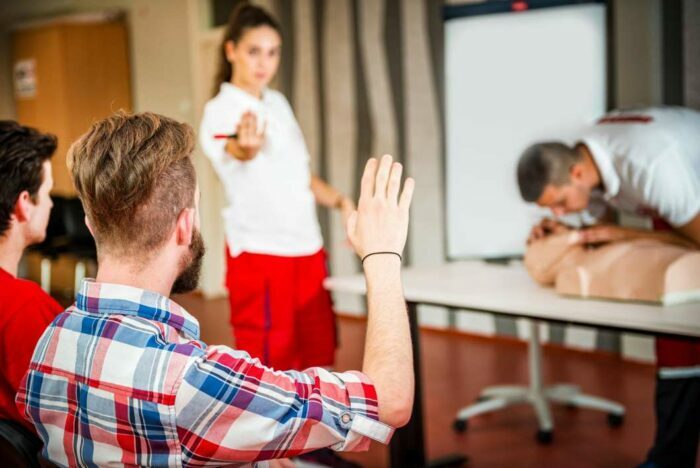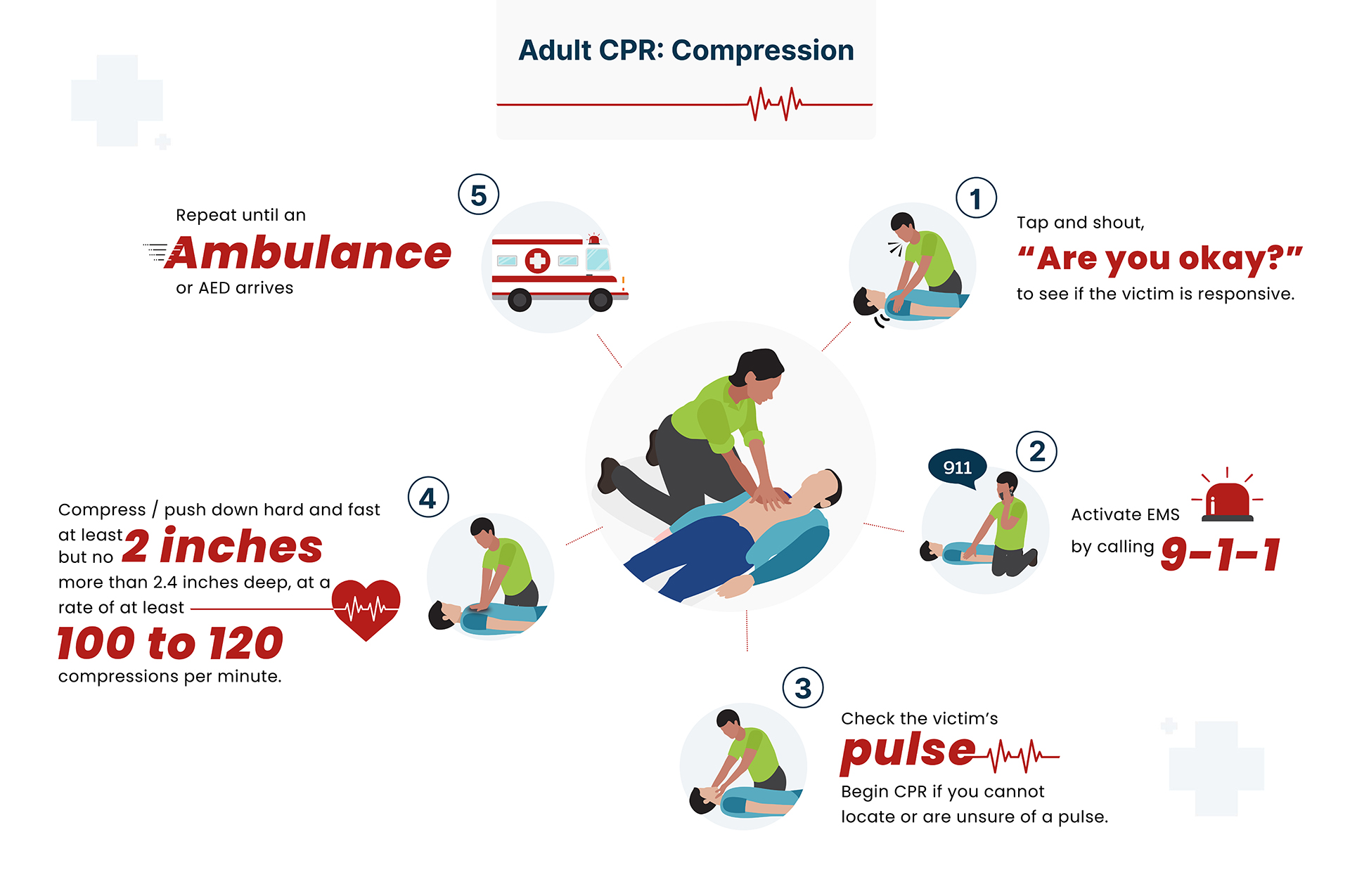The Importance of BLS for Police Officers: How it Can Save Lives?
13/11/2024

February 08, 2021
Nearly 475,000 people die annually from cardiac arrest in the United States. Out of this group, roughly 350,000 occur outside a hospital. So, the question remains: Why aren’t more bystanders taking an online CPR class? Part of the reluctance to take CPR classes stems from the question, “How long does a CPR class take?”
CPR online classes are generally not lengthy. The entire CPR certification course registration process is completed within minutes. With the rise of flexible online course models, you can break your course into shorter sections or learn it all simultaneously.
The CPR certification expires within the next two years of its commencement. However, you can renew your CPR certification on time when you repurchase your course codes. Several jobs require CPR certification, especially when entering a medical profession. Thus, it is essential to know how long CPR certification is good for and when it expires.
A new Cleveland Clinic survey shows that only 54% of Americans say they know how to perform CPR. To make matters worse, only 11% know the correct pace for performing emergency chest compressions. These statistics show how important it is for you to start considering CPR certification.
At the American HealthCare Academy, we believe in making your life easier by offering CPR renewal classes with easy-to-control learning paces and instant proof of certification to immediately show to your employer.
Our CPR certification course will give you the skills and confidence needed to act in the event of an emergency. Don’t hesitate any longer. You never know whose life may depend on your first aid CPR training.
Cardiopulmonary resuscitation (CPR) is a life-saving procedure that uses chest compressions and rescue breaths to preserve blood circulation and brain function.
CPR is statistically proven to increase a victim’s chances of surviving a cardiac arrest by almost 300%. And anyone, even a 9-year-old child, can learn and retain the process of CPR.
Put simply, CPR saves lives. For the 350,00 people who experience cardiac arrest outside the hospital, CPR is the only thing between them and permanent brain damage or death.
CPR is also an essential skill required by many employers.
The length of a CPR class depends on which course type you enroll in. More advanced and in-person courses take approximately 2.5-3 hours. A First Aid/CPR class can take longer, up to 4-6 hours.
Your CPR class duration also depends on whether you enroll in a class with primarily first-timers or recertification students. If you enroll in a course full of mostly recertification students, your class will be shorter than one filled with first-time students.
Online classes give you more control over how long CPR certification takes. You can complete online CPR classes in as little as 30-90 minutes or as long as a few days. The benefit of this option is that you get to tailor your course schedule to your needs.
CPR instructor classes take longer, and they are more intensive. These classes can take as long as 6 hours to complete. After instructors complete the 6-hour essentials class, they have to complete a 6-month monitoring period.
Determining how long your CPR classes should take also depends on which association you use and how their platform is structured. Some associations and services take longer than others due to differences in curriculum and course layout.
CPR classes typically start with a brief introduction to CPR guidelines. From there, you will learn how to prepare for medical emergencies such as sudden cardiac arrest, choking, and strokes.
It’s easy to panic in medical emergencies. CPR training gives you the tools to overcome fear and take decisive action. Understanding the difference between these emergencies will help you feel more confident if you find yourself in a medical emergency.
How long your online CPR class takes depends on how you split the curriculum. If you’re taking online courses, separating adult CPR, infant CPR, and children CPR is an effective way to split up your curriculum.
The adult CPR section teaches you everything you need to do in the case of an adult cardiac arrest victim.
The steps for adult CPR are different from child and infant CPR. First, call 911. Then, tell another bystander to locate an AED and begin chest compressions.
Adult Emergency CPR also teaches you:
Chest compressions for adults should be two inches, and their chest should rebound completely in between compressions.
Children have higher survival rates for immediate CPR than adults. Part of this is because children’s hearts are typically more resistant than adults. Another reason is children are more likely to need CPR for a blocked airway rather than a cardiac arrest.
In child CPR, you should start chest compressions immediately. After two minutes of chest compressions and rescue breaths, call 911 and return to CPR. Chest compressions for children should only be one and a half inches. Use the pediatric pads after five CPR cycles if an AED is available.
The online Child CPR class teaches you everything that adult CPR classes teach. However, they tend to take an hour or two longer since you must learn how to respond to different age groups. Then, there are Basic Life Support or BLS classes online that combine the education of CPR on children, infants, and adults. The duration is the same, but the credibility or authenticity of the student’s certification will be higher when they pass the BLS comb course with CPR and First Aid.
Babies are more delicate than adults. That’s why infant CPR courses are different from children and adult CPR. To confirm the baby is unconscious, you shouldn’t shake them like a child or an adult. Instead, flick the soles of their feet and shout.
You should begin CPR on infants before calling 911. To check the baby’s pulse, place your fingers on the inside of their upper arm. When providing rescue breaths, you must be careful not to tilt the head too far back. Infant chest compressions should only be about an inch and a half deep.
When asking, “how long does a CPR class take,” you also have to consider whether there are any add-ons to the class such as AED, First-Aid, or Bloodborne Pathogens. Classes also take longer for healthcare professionals because they are more intensive.
Before the internet, CPR classes required rearranging your schedule to accommodate. Now, things are different, and you can access high-quality CPR training from the comfort of your home.
At the American Health Care Academy, we give you access to comprehensive online CPR certification, making saving lives simple and CPR training accessible. Our CPR classes follow updated guidelines and standard procedures. Whether you’re inexperienced or you need to get recertification, the American Health Care Academy can help.
Some of our course combinations include:
We have certified CPR teachers to help guide you through your training, ensuring that you learn all of the valuable CPR skills necessary to perform life-saving techniques. You can also register for a combo course like Basic Life Support (BLS) which also teaches you CPR and First aid as the core part of the curriculum.
Our classes offer an affordable alternative to in-person classes, which can hinder your schedule and become more of a hassle than a rewarding experience. With online CPR certification and recertification courses, there’s simply never been a better time to learn this valuable skill.

DOES IT MATTER WHERE YOU GET CPR CERTIFIED?
Think again if you believe that all CPR certification is made equal. When it comes to efficiently acquiring a skill, there are a lot of different aspects that come into play, some of which include the manner of instruction, the quality of the curriculum, and even the experience level of the teacher.
When it comes to doing CPR, this is of the utmost significance since we are attempting to save a person’s life. A comprehensive knowledge not just of how chest compressions are performed, but also of the many other methods that can be used in an emergency setting to save a person’s life is necessary in order to perform CPR successfully. The failure of professionals to do their jobs correctly or having knowledge gaps can have severe repercussions.
DOES THE WAY IN WHICH YOU PERFORM CPR CHANGE?
Guidelines for practicing CPR are reviewed and updated every five years, and during the past 10 years, there have been major shifts in the manner in which the skills are taught and performed in both classroom and real-world settings. This implies that if you acquired your certification a long time ago, the CPR you learned then is likely to be different from the CPR you would learn today.
If you received your certification more recently, the CPR you learned is likely to be the same. The American Heart Association (AHA) issued its first set of guidelines based on the new methodology in the year 2020. There are 491 separate guidelines that are included in this category, and they are spread over both layman CPR and CPR performed by healthcare providers.
WHY DO SOME PEOPLE HESITATE TO LEARN CPR?
Consider the following information from the American Heart Association (AHA) to obtain a better understanding of the need of doing CPR in critical situations:
Seventy percent of Americans have the misconception that they are unable to take any action in the event of a cardiac emergency because they are unable to conduct cardiopulmonary resuscitation (CPR) or because their CPR training has expired.
HOW LONG SHOULD ONE WAIT BEFORE RECERTIFICATION?
Your CPR certification is valid for two years. However, studies show that your CPR skill retention drops after six months. For this reason, we offer CPR certification and recertification classes to keep your skills current.
ARE THE INSTRUCTORS CERTIFIED?
Our OSH-trained instructors are 100% certified to teach CPR to healthcare officials and everyday people. They stay up to date with advances in healthcare and CPR safety training.
HOW LONG AFTER THE CLASS BEFORE I GET MY CERTIFICATE?
You can have instant access to your CPR card as soon as you finish the exam. After you’ve passed the final quiz, simply download and print off your CPR certification card for instant proof of verification.
WHY CPR MATTERS
Consider the following facts from AHA to gain a better understanding of the need of CPR in emergencies:
Get CPR-Certified Online and Gain the Confidence You Need To Save a Life
Given that only half of Americans say they would feel comfortable performing CPR, the demand for CPR-certified individuals has never been higher.
When asking “how long how long is CPR certification good for?” consider CPR online classes with the American Health Care Academy. Renew your CPR certification today and be the best medical professional you want to be.
Our online classes let you control your learning pace and give you instant access to your certification so you can print it off and show your employer.
Additionally, when you learn CPR techniques, you give yourself the tools to protect your loved ones. Join the American Health Care Academy and improve your life-saving skills today. You never know when you may need them.